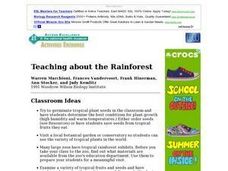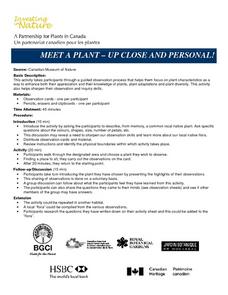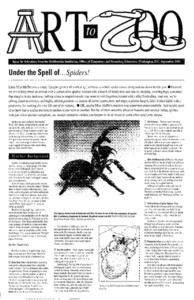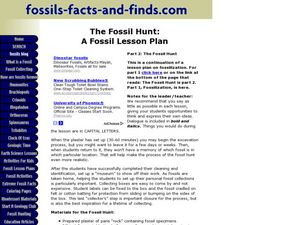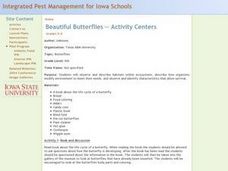Curated OER
Native American Three Sisters Gardens
Learners investigate companion planting. In this communtiy gardening lesson students explore the tradition of the Native American Three Sisters gardening approach. Learners act as botanists, anthropologists, folklorists, and curators.
Curated OER
No Bones About It
Students act as paleontologists, examining pictures of dinosaur skeletons and applying their knowledge of the relationship between skeletal features and survival, to create 'Paleontology Reports' about their perceptions of the lives of...
Curated OER
The Arthropod Story
Students learn a number of evolutionary concepts by following the long history of the arthropods and have opportunities to think about arthropod evolution in terms of both opportunities and constraints.
Curated OER
A Dog's Life
Middle schoolers get a look into the life of dogs-from their origins and basic biology, through selective breeding, and into how dogs have become intricate parts of everyday life for many people worldwide.
Curated OER
Frogs Losing Ground
Learners explore an exhibit through an interactive program on frogs. They can listen to the different sounds frogs make and the different types of frogs. They search for the types of frogs they find in their local area.
Curated OER
Expedition Stories
Students use the Internet to research and discover information about expeditions that were formed to observe the transit of Venus. In groups, they work together to present information about the expeditions and create a visual aid.
Curated OER
Fabulous Fossils
Students investigate how fossils are formed. They read the book, "Digging Up Dinosaurs," examine fossil samples, create a fossil imprint using play-doh, and complete a Fossil Questionnaire activity sheet.
Curated OER
Water-The Liquid Gold
Learners investigate the necessity of water for the survival of plants, animals, and people. They explore the affect that water has on human and natural environments through literature, field trips, and discussions.
Alabama Learning Exchange
Is it a Moth or a Butterfly?
Second graders examine the similarities and differences between moths and butterflies. They participate in a virtual field trip using a designated web site. They design a computer based slideshow using the information they find on the...
Curated OER
The Facts of Life
Young scholars explore the different ways scientists gather information about extinct animals. They utilize these methods to create illustrated story books about a particular extinct animal.
Curated OER
Teaching about the Rainforest - Classroom Ideas
Students are introduced to the tropical rainforest through different ways that catch their attention such as: Visit a local botanical garden or conservatory so that students can see the variety of tropical plants in the world. They...
Curated OER
MEET A PLANT - UP CLOSE AND PERSONAL!
Learners sharpen their observation and inquiry skills. They participate in a guided observation process that helps them focus on plant characteristics as a way to enhance both their appreciation and their knowledge of plants, plant...
Curated OER
What Teeth Tell Us
Young scholars view pictures of a variety of animals. They examine the animals' teeth and discuss the differences in them. They experiment with staple removers (carnivore teeth) and two flat rocks (herbivore teeth) and determine which...
Curated OER
Digging Up Dinosaurs
In this report writing worksheet, students prepare to write a dinosaur report by selecting and reading a nonfiction book. Students choose one dinosaur and write a report following the specific guidelines on this page.
Curated OER
The Greatest Show on Earth: The World's Smallest Animals
Students create instruments to capture different types of insects. In this The Greatest Show on Earth: The World's Smallest Animals instructional activity, students compare the attributes of certain insects and record the data on a...
Curated OER
Airplanes and Airports: How To Take Off Without Ever Leaving the Ground
Students plan an airport visit. In this Airplanes and Airports instructional activity, students observe the people, activity, and machinery at airports. Then students compare the characteristics of their observations at the airport....
Curated OER
Under the Spell of Spiders!
Young scholars read about spider body parts, abilities, tendencies, and life cycles. In this Under the Spell of Spiders! lesson, students create mystery creatures that turn out to be spiders. Young scholars catch and observe spiders and...
Curated OER
Math Skills: Conversions
In this conversions worksheet, students use metric unit conversions to solve fifteen word problems that involve converting from one unit to another.
Curated OER
Life in Ancient Mesopotamia
Students reconstruct and make drawings of vessels in the same manner as an archaeologist. In this archaeologist lesson plan, students each get a piece of a broken pot and they have to work together to put it back together. Once it is...
Curated OER
The Fossil Hunt
Learners recall prior knowledge of the process of fossilization. For this fossils lesson, students first create and at a later date, recover fossils. Learners understand the painstaking process of recovering a fossil. Students recover...
Curated OER
Life In the Soil: Home Sweet Home: Red Worms
In this soil worksheet, students complete 2 pages about the importance of soil in plant growth. Students read about red worms and answer 2 questions about composting. Students fill out a chart with their observations of plants planted in...
Curated OER
Beautiful Butterflies - Activity Centers
Students describe habitats within ecosystems, describe how organisms modify environment to meet their needs, and identify characteristics for butterfly survival. In this butterfly lesson plan, students explore all aspects of the...
Curated OER
What is Cacao?
Students use the Internet to learn about the cacao plant. In this plants lesson, students complete a KWL chart on chocolate, learn about cocoa plants and discuss the parts of a plant. Students use the Internet to learn how the cacao...
Curated OER
A Strange Fish
Students research the sea horse. In this sea horse lesson, students use the Internet to find information about the sea horse on sites bookmarked by the teacher. The students write these facts on a page and create a sea horse poem.












